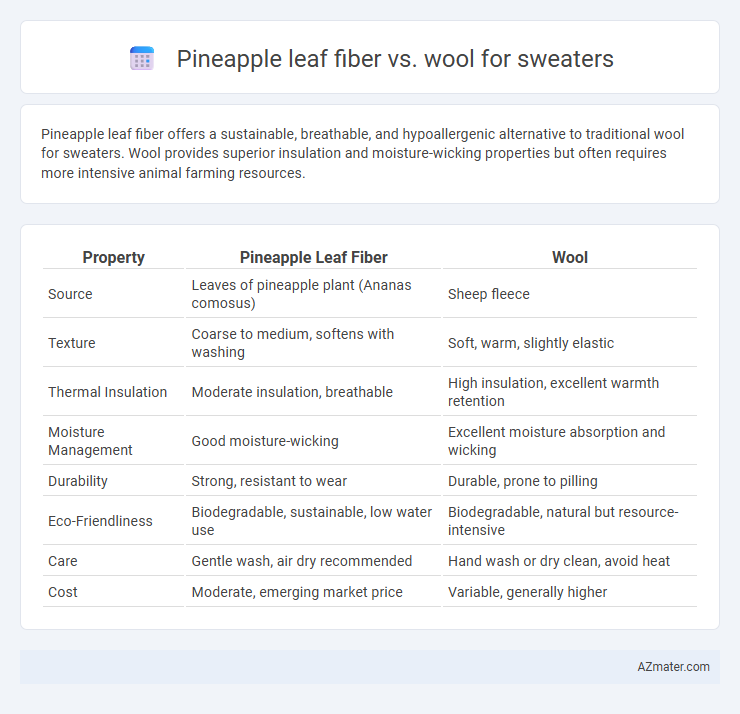Pineapple leaf fiber offers a sustainable, breathable, and hypoallergenic alternative to traditional wool for sweaters. Wool provides superior insulation and moisture-wicking properties but often requires more intensive animal farming resources.
Table of Comparison
| Property | Pineapple Leaf Fiber | Wool |
|---|---|---|
| Source | Leaves of pineapple plant (Ananas comosus) | Sheep fleece |
| Texture | Coarse to medium, softens with washing | Soft, warm, slightly elastic |
| Thermal Insulation | Moderate insulation, breathable | High insulation, excellent warmth retention |
| Moisture Management | Good moisture-wicking | Excellent moisture absorption and wicking |
| Durability | Strong, resistant to wear | Durable, prone to pilling |
| Eco-Friendliness | Biodegradable, sustainable, low water use | Biodegradable, natural but resource-intensive |
| Care | Gentle wash, air dry recommended | Hand wash or dry clean, avoid heat |
| Cost | Moderate, emerging market price | Variable, generally higher |
Introduction to Sustainable Sweater Materials
Pineapple leaf fiber, derived from agricultural waste, presents a biodegradable and eco-friendly alternative to traditional wool in sweater production, offering durability and moisture-wicking properties. Wool, harvested from sheep, is a natural fiber renowned for its insulation, breathability, and long-standing use in sustainable fashion. Both materials contribute to reducing environmental impact, with pineapple leaf fiber emphasizing plant-based innovation and wool leveraging renewable animal resources.
What Is Pineapple Leaf Fiber?
Pineapple leaf fiber (PALF) is a natural, sustainable textile fiber extracted from the leaves of the pineapple plant, known for its high tensile strength and durability. Compared to wool, PALF is lightweight, hypoallergenic, and resistant to moisture, making it suitable for eco-friendly sweaters designed for sensitive skin and warmer climates. The extraction process of PALF involves decortication, which separates the fibers without harming the pineapple plant, enhancing its appeal as an environmentally conscious alternative to traditional wool fibers.
Understanding Wool as a Textile
Wool, derived from sheep fleece, offers natural insulation, moisture-wicking properties, and breathability, making it an excellent textile for sweaters in cold climates. Its fiber structure provides elasticity and resilience, allowing wool garments to maintain shape and resist wrinkling over time. Unlike pineapple leaf fiber, which is plant-based and coarse, wool delivers superior warmth and softness but requires careful laundering to prevent shrinkage and felting.
Environmental Impact: Pineapple Leaf Fiber vs Wool
Pineapple leaf fiber offers a sustainable alternative to wool by utilizing agricultural waste, reducing deforestation and water consumption typically associated with sheep farming. Wool production often involves methane emissions and land degradation, whereas pineapple leaf fiber boasts a lower carbon footprint and minimal chemical processing. Choosing pineapple leaf fiber for sweaters supports eco-friendly practices by promoting resource efficiency and reducing greenhouse gas emissions.
Comfort and Wearability Comparison
Pineapple leaf fiber offers lightweight breathability and natural moisture-wicking properties, making it comfortable for warmer climates compared to wool's superior insulation and softness, ideal for cold weather. Wool excels in thermal regulation and elasticity, providing long-lasting wearability and resistance to wrinkles, while pineapple fiber is more rigid but sustainable and hypoallergenic. Both fibers deliver distinct comfort benefits, with wool favored for its cozy warmth and pineapple leaf fiber for its eco-friendly, breathable texture.
Durability and Longevity in Sweaters
Pineapple leaf fiber exhibits exceptional durability and resistance to wear, making sweaters crafted from this material long-lasting and less prone to pilling or tearing. Wool offers natural resilience and elasticity, which helps sweaters retain shape over time, but may be susceptible to moth damage and requires careful maintenance. When comparing longevity, pineapple leaf fiber provides sustainable strength with less degradation, while wool's durability depends heavily on proper care and environmental conditions.
Moisture Absorption & Breathability
Pineapple leaf fiber outperforms wool in moisture absorption due to its natural hydrophilic properties, absorbing sweat quickly and enhancing comfort during physical activities. Its breathable structure allows better air circulation, reducing heat retention compared to wool, which tends to trap moisture despite its insulating qualities. This makes pineapple leaf fiber sweaters ideal for warm climates or active wear, whereas wool excels in colder environments with moderate breathability.
Ethical and Animal Welfare Considerations
Pineapple leaf fiber offers a sustainable and cruelty-free alternative to wool, as it is derived from agricultural waste without harming animals. Unlike wool production, which involves sheep shearing and sometimes contributes to animal stress or unethical practices, pineapple fiber production supports environmental conservation and fair labor conditions. Choosing pineapple leaf fiber sweaters aligns with ethical fashion principles by reducing animal exploitation and promoting eco-friendly textile innovations.
Cost and Accessibility
Pineapple leaf fiber sweaters tend to be more affordable due to the utilization of agricultural waste and lower processing costs compared to traditional wool. Wool, sourced from sheep, often incurs higher prices related to animal care, shearing, and supply chain complexity. Accessibility-wise, wool is widely available in global markets, whereas pineapple leaf fiber remains niche, primarily produced in regions with pineapple agriculture like the Philippines.
Which Material Is Better for Sweaters?
Pineapple leaf fiber offers sustainability, breathability, and natural moisture-wicking properties, making it ideal for lightweight, eco-friendly sweaters, while wool excels in warmth, insulation, and durability, perfect for cold-weather garments. Wool's elasticity and ability to retain heat surpass pineapple leaf fiber, which is less elastic and better suited for moderate climates. Choosing between the two depends on the desired balance of environmental impact, temperature regulation, and garment longevity.

Infographic: Pineapple leaf fiber vs Wool for Sweater
 azmater.com
azmater.com